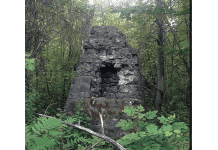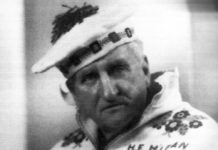Is there anything sadder than a memorial that no-one remembers? In the first half of the last century, Deek’s Quarry was a hive of activity. At one time, around 200 workers were employed in crushing rocks to be used as rail beds for the Canadian Pacific Railway and the Ontario Northern Railway. The contract for the crushed rock had been granted to Dominion Construction Limited of Montreal, owned by Harry Falconer McLean. In order to obtain the ballast for the tracks a division of his company, Grenville Crushed Rock Ltd was established at the site on Scotch Line Road and a production plant set up to crush the road bed ballast.
McLean bought the land for the quarry in 1919 and the operation continued until 1932, and at its peak, almost three million tons of local limestone was quarried every year. The work was hard and dangerous and there were deaths among the workers. When the quarry closed, McLean erected a stone cairn in memory of the dead workers, one of around a dozen such memorials he built at various quarries he owned across Canada.
On the stone monument metal plaques were mounted carrying the names of the dead, and one side was placed a poem, “The Sons of Martha”, which McLean had commissioned from famous British Imperialist, Rudyard Kipling. Many are the stories about Harry McLean, especially during the last decades of his life, which he spent in the Merrickville area. Deek’s Quarry, also, is a place of historic importance. During the Second World War, the disused quarry was used as a staging point for trains carrying munitions and equipment eastward to Halifax to be sent on ships to Britain.
But time was not kind to the McLean Cairn, and it remained neglected and vandalised for many years. The metal plaques were removed and some, at least, ended up in the care of the Historical Society in Merrickville. But the cairn itself became lost in overgrown bush and the memories of local residents until a few individuals decided in 2001 to see about moving it to Merrickville for preservation. The plan was to have it sited on the green space beside the cenotaph.
It was then that John Shawarna, one of those involved in the project, says they made their first mistake: they informed the Township of North Grenville of their plans. Meant as a polite gesture, it led instead to the North Grenville (Local Architectural Conservation Advisory Committee [LACAC] to recommend to the municipal council that the cairn be given a heritage designation, which would prevent it being moved to Merrickville.
An appeal to the Ontario Conservation Review continued from front page
Board took place in July, 2002 resulted in a recommendation that the cairn be designated on site. John Shawarna remembers being quite unimpressed by the Board hearing, and disappointed that the residents group had been thwarted in their attempt to protect the cairn from further damage.
Throughout 2002 and 2003, meetings were held in North Grenville as steps where discussed whereby the cairn would be renovated and negotiations took place with the then-owner of the site, Barry Forbes, who was prepared to contribute to the costs. The Algonquin College Heritage Institute’s Heritage Masonry program was recruited to restore the stonework of the cairn. The Historical Societies in both North Grenville and Merrickville-Wolford joined in the project. Everything seemed to promise a speedy and professional restoration of the McLean Cairn to its rightful heritage state.
But, at that point, it seems that everything stopped. The North Grenville council refused any financial support for the restoration, and would not agree to purchase the site from Barry Forbes. No tax receipts would be issued by the municipality for donations of materials to use in the project. In short, after all the effort, conflicts, and time, the cairn remained where it was, in its dilapidated state. In fact, the cairn became even less accessible when the Municipality of North Grenville closed that part of Scotch Line Road to vehicles a few years ago, so anyone wishing to see the cairn had a bit of a walk to get to it. In addition, the
cairn is now in a very sad state, easy to miss as you walk along the road, and apparently destined to simply fall apart in time.
The aim of McLean in 1932 was to provide a memorial to the workers of Deek’s Quarry, itself an historic site that has been left to decay. The words of Rudyard Kipling, along with the names of the workers memorialised, have been removed from the cairn and from the site.
Perhaps, in hindsight, it would have been better if those concerned citizens in 2001 had just moved the cairn to Merrickville, where it could be restored and preserved for future generations. Then the memorial would achieve its proper purpose. Is it too late to do something now?








…and when we were there we didn’t even recognize it as a cairn! 27 April 2018 – Canada: Ontario: Grenville County: N of Scotch Line Rd at Deeks Quarry, 3.30 km NNE Newmanville. (25m waypoint), 44.95737° N 75.74146° W TIME: 1535. AIR TEMP: circa 16°C, light overcast, breezy. HABITAT: Aspen/mixed thickety woods near abandoned limestone quarry. OBSERVER: Frederick W. Schueler, Clay Shearer. 2018/060/ga, visit (event). ruin, walk. WAYPT/061, old chimney with fire-place-like openings. – Clay remembers this from childhood visits, and he determined its age as relatively recent from the mortar being Portland cement. This has Hemerocallis fulva (Orange Daylily) nearby, an indication of occupancy as a homestead.
(same location) 2018/060/gb, Celastrus scandens (Climbing Bittersweet) (Plant). vine, in fruit. vines in small trees, fruit clusters on ruined chimney.
(same location) 2018/060/gc, Pseudacris ‘brown-maculata’ (GreatLakes-StLawrence Chorus Frog) (herp). index1-2? calling, heard. some calling to S.
(same location) 2018/060/gd, Rana sylvatica (Wood Frog) (herp). index1-2? calling, heard. some calling to S.
Maybe the present council will let it be moved
For anyone interested in finding it, there is a geocache placed by the monument, with very accurate GPS coordinates. https://coord.info/GC8X5CC